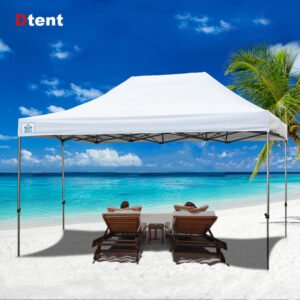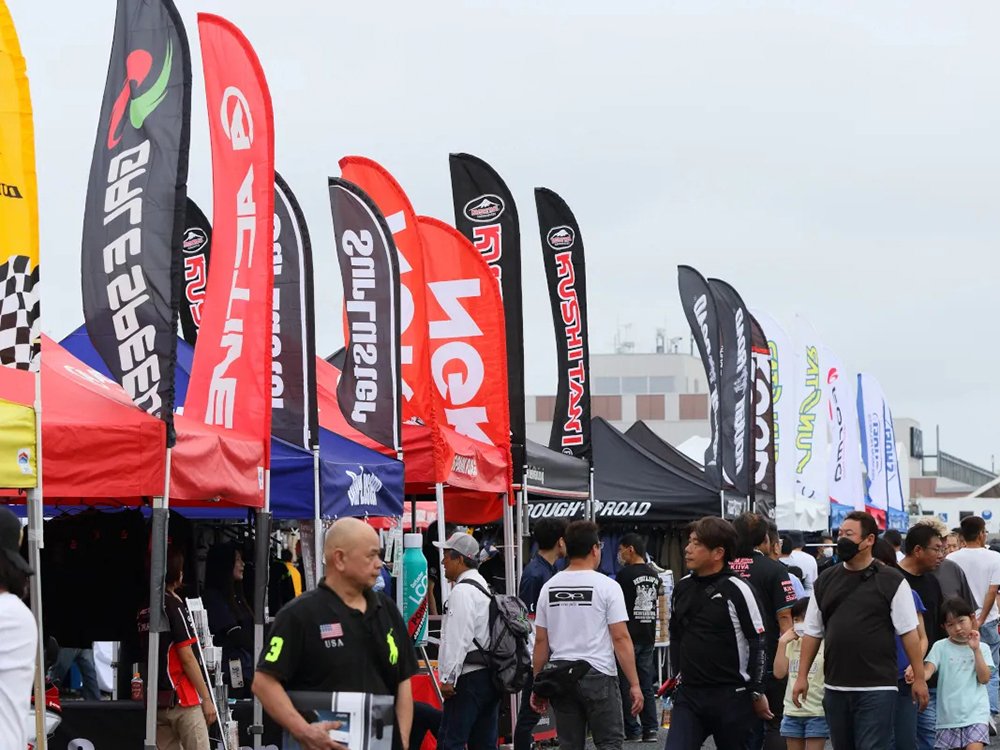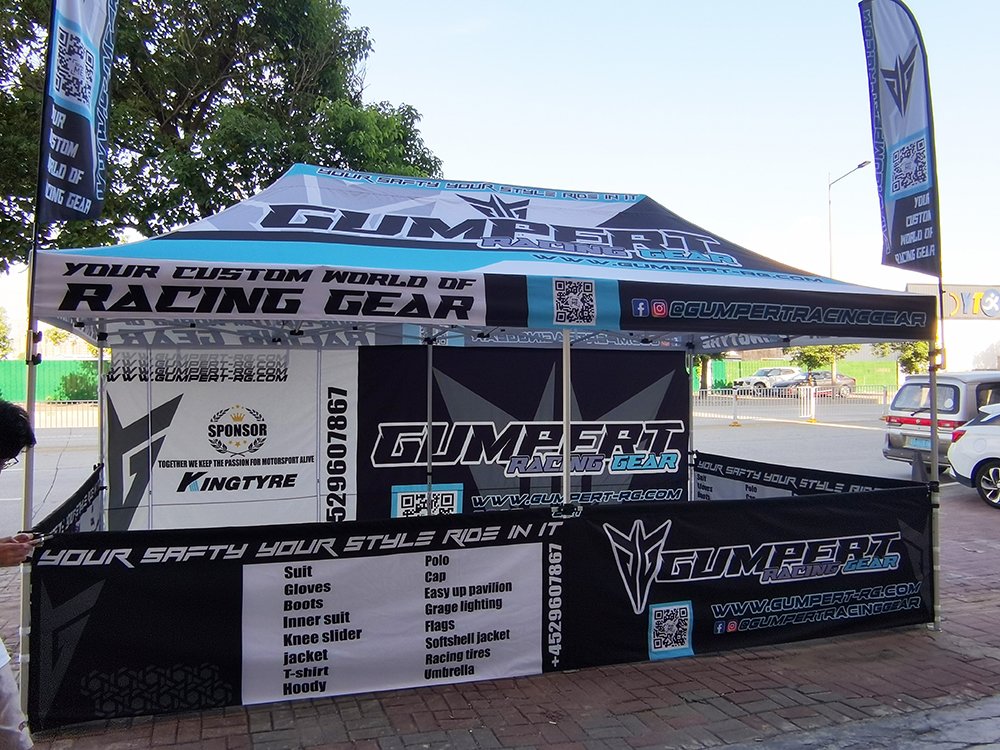Last Updated on 06/03/2025 by dtent.net
As professional tent manufacturers, we know that even the most advanced tents face their toughest challenges in extreme weather. From howling winds and torrential rains to scorching heat and heavy snow, nature’s fury can test the limits of any shelter. However, with the right knowledge and preparation, you can safeguard your tent and ensure it remains a reliable refuge. In this comprehensive guide, we’ll explore proven techniques to protect your tent in severe weather, drawing on decades of engineering expertise and real-world testing.
1. Understanding Weather-Specific Threats
Before diving into solutions, it’s crucial to recognize how different weather conditions impact tents:
| Weather Type | Primary Risks |
|---|---|
| Heavy Rain/Storms | Water ingress, seam leakage, wind damage, flooding. |
| High Winds | Pole collapse, fabric tearing, stake pull-out, structural deformation. |
| Snowfall | Snow load stress, condensation, fabric abrasion from ice, pole buckling. |
| Extreme Heat/Sun | UV degradation, fabric delamination, overheating, zipper/jacket failure. |
| Sandstorms/Dust | Abrasion, sand infiltration, zipper jams, reduced visibility. |
Each scenario demands tailored strategies. Let’s break them down.
2. Stormproofing Your Tent: Battling Rain and Floods
Torrential rain is a top cause of tent failure. Here’s how to stay dry and secure.
A. Site Selection and Preparation
- Avoid low-lying areas: Camp on elevated ground to prevent flooding.
- Check drainage: Ensure the site slopes slightly to channel water away.
- Use a footprint: A waterproof groundsheet adds an extra moisture barrier.
B. Waterproofing Upgrades
- Seam sealing: Reapply silicone-based sealant to all seams annually.
- Rainfly optimization:
- Extend the rainfly 6–8 inches beyond the tent body for drip-free coverage.
- Angle the rainfly steeply to shed water quickly.
- Add a vestibule: Attach a vestibule tarp for dry gear storage and cooking.
C. Wind-Driven Rain Defense
- Guyline tensioning: Tighten guylines to prevent rainfly flapping, which can funnel water inside.
- Batten down doors: Close and secure all zippers, flaps, and storm doors.
- Use a weather-resistant tent: Opt for tents with a hydrostatic head (HH) rating of 3,000mm+.
Pro Tip: In monsoons, dig a shallow trench around the tent (6 inches deep, 1 foot away) to divert runoff.
3. Windproofing: Surviving Gale-Force Winds
High winds can collapse tents, snap poles, and shred fabrics. Mitigate risks with these tactics.
A. Structural Reinforcements
- Pole strength: Use aluminum or carbon fiber poles instead of fiberglass.
- Cross pole designs: Geodesic or semi-geodesic tents distribute wind load evenly.
- Guyline networks: Attach guylines to every reinforced loop, angled at 45° from the tent.
B. Anchoring Techniques
- Stake upgrades: Replace stock stakes with heavy-duty options:
- Sand/snow: 12-inch V-shaped stakes or deadman anchors (e.g., buried logs).
- Rocky terrain: Needle-nose stakes or rock pegs.
- Weighted anchors: Place heavy rocks or gear inside the tent corners.
C. Windbreak Strategies
- Natural barriers: Pitch behind boulders, dense trees, or hills.
- Artificial windbreaks: Erect a tarp wall or snow fence 10–15 feet upwind.
- Low-profile pitching: Lower the tent height and angle it into the wind.
Pro Tip: In sustained winds >40 mph, add a second layer of guylines using trucker’s hitch knots for adjustable tension.
4. Snow Camping: Managing Weight and Cold
Heavy snow loads and subzero temps demand specialized preparation.
A. Structural Support
- Pole reinforcement: Use poles with larger diameters (e.g., 11mm+ aluminum).
- Snow load shedding: Choose tents with steeply sloped roofs (≥60°) to prevent snow accumulation.
- Internal supports: Add a center pole or horizontal crossbar for extra strength.
B. Snow Anchoring
- Deadman anchors: Bury stuff sacks, skis, or snowshoes 1–2 feet deep.
- Snow stakes: Use wide, plastic stakes designed for soft snow.
- Snow walls: Build walls around the tent to deflect wind and drifting snow.
C. Condensation Control
- Ventilation balance: Crack vents slightly to allow moisture escape while retaining heat.
- Double-wall tents: The air gap between the inner tent and rainfly reduces condensation.
- Liner use: Hang a moisture-wicking liner to catch drips.
Pro Tip: Brush snow off the tent every 2–3 hours to prevent overloading.
5. Heat and UV Protection: Preventing Sun Damage
Prolonged sun exposure weakens fabrics, fades colors, and turns tents into ovens.
A. UV-Resistant Materials
- Fabric choice: Polyester tents resist UV degradation better than nylon.
- Coatings: Opt for tents with UV-protective treatments (e.g., Sunbrella®).
- Color selection: Light-colored tents reflect sunlight; dark colors absorb heat.
B. Cooling Strategies
- Shade tarps: Drape a reflective tarp 2–3 feet above the tent for airflow and shade.
- Cross-ventilation: Open opposing vents and doors to create a breeze.
- Evaporative cooling: Hang damp towels inside or mist the tent exterior.
C. Heat-Resistant Maintenance
- Avoid hot surfaces: Don’t pitch tents on asphalt or sand-over-rock, which radiates heat.
- Reapply UV protectant: Use sprays like 303 Aerospace Protectant annually.
Pro Tip: In deserts, bury tent edges in sand to block hot winds and stabilize the structure.
6. Sandstorm and Dust Defense
Abrasive sand and dust infiltrate zippers, abrade fabrics, and reduce visibility.
A. Sealing the Tent
- Full-coverage rainfly: Ensure no gaps between the rainfly and ground.
- Zipper guards: Attach fabric flaps over zippers to block sand.
- Duct tape seals: Temporarily tape seams and vents in extreme storms.
B. Cleaning and Maintenance
- Post-storm shakeout: Vigorously shake the tent to remove sand.
- Zipper care: Clean zippers with a soft brush and lubricate with silicone spray.
- Fabric inspection: Check for abrasion and repair with Tenacious Tape®.
C. Visibility and Safety
- Use goggles and masks: Protect yourself while securing the tent.
- Anchor securely: Sandstorms often bring high winds; double-stake guylines.
Pro Tip: Pitch tents parallel to the wind to minimize sand accumulation on one side.
7. Emergency Repairs in the Field
Even with precautions, emergencies happen. Be ready with these quick fixes:
A. Pole Failure
- Splint broken poles: Use a tent pole repair sleeve, stick, or duct tape.
- Guylines as substitutes: Rig guylines as makeshift poles for dome tents.
B. Fabric Tears
- Patch kits: Apply adhesive patches or tape to both sides of the tear.
- Sewing repairs: Use dental floss or a needle/thread for small holes.
C. Zipper Jams
- Lubricate: Apply lip balm, candle wax, or silicone spray.
- Force gently: Slowly work the zipper back and forth to dislodge debris.
Pro Tip: Carry a multi-tool with pliers, scissors, and awl for on-the-go fixes.
8. Choosing the Right Tent for Extreme Weather
As manufacturers, we emphasize that prevention starts with tent selection. Key features to prioritize:
A. Stormworthy Tents
- Full-coverage rainfly: Seamlessly covers all doors and vents.
- Reinforced seams: Double- or triple-stitched with bar-tacks at stress points.
- Bombproof zippers: YKK® AquaGuard or similar waterproof zippers.
B. Four-Season Tents
- Robust poles: 7000-series aluminum or carbon fiber.
- Dual vents: Top and bottom vents for condensation control in snow.
- Snow skirts: Fabric flaps that block drifting snow.
C. Desert/Sandstorm Tents
- Mesh-free designs: Minimal mesh to keep dust out.
- Abrasion-resistant floors: 150D polyester or PVC-coated bases.
9. Post-Weather Care: Extending Tent Lifespan
After surviving harsh conditions, proper care ensures your tent is ready for the next adventure.
A. Post-Storm Cleaning
- Rinse salt/sand: Use fresh water to prevent corrosion and abrasion.
- Dry thoroughly: Hang in shade with all doors/vents open.
B. Inspection Checklist
- Poles: Check for bends, cracks, or joint looseness.
- Fabrics: Look for UV fading, delamination, or pinholes.
- Stakes/guylines: Replace rusted stakes or frayed lines.
C. Professional Servicing
- Re-waterproofing: Send to the manufacturer for industrial recoating.
- Seam resealing: Factory-applied sealant lasts longer than DIY kits.
Pro Tip: Document damage with photos for warranty claims or insurance.
Resilience Through Preparation
Extreme weather demands respect, but it doesn’t have to end your adventure. By combining smart tent selection, proactive reinforcement, and swift repairs, you can transform your tent into an unyielding fortress against nature’s worst.
At Dtent, we engineer tents to meet these challenges head-on—using aerospace-grade materials, precision craftsmanship, and relentless testing. Explore our [Extreme Weather Collection] to find shelters built for the harshest conditions, or contact our experts for personalized advice. Remember, the wild may test your tent, but with the right preparation, you’ll always weather the storm.
Our story began 15 years ago, when we established our factory with the vision of becoming the leading producer of customized tents, canopies, flags, umbrellas, and other related products. Since then, we have been dedicated to providing high-quality and tailor-made solutions for our clients, partnering with numerous reputable brands in the industry.
We are a professional factory specializing in the production of custom-made tents, canopies, flags, and other event supplies. With 15 years of experience, we have a strong research and development team and impressive production capabilities. We have also served many brand clients and have earned a solid reputation in the industry.
Are you a Trading Company or Manufacturer?
We are a manufacturer specialized in Folding tents, Outdoor umbrellas, Beach flags, Advertising Banners
Can you do design for my ideas or drawing?
Yes, we have experienced designers and our own molding factory. According to your requirements, we can design or open mold which has a competitive price.
Can you print any logo for customer?
Yes, both OEM and ODM is available.
How long does sample take?
Sample will be ready within 5-7 days, depends on your printing and material requirements.
What is your advantage?
Cost effective; with low price; Time effective: we promise to make the mass delivery within 30 days Service effective: Our sales people promise to reply your enquiry within 12 hours.
Can I make my customize logo and packaging?
Yes, please contact us for specific details if you need a logo or custom packaging.














